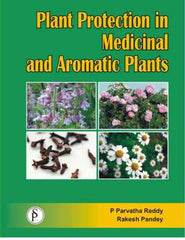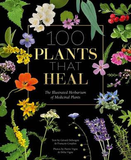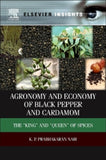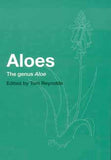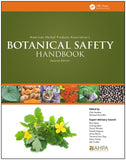Plant Protection in Medicinal and Aromatic Plants by P. Parvatha Reddy and Rakesh Pandey
Plant Protection in Medicinal and Aromatic Plants
Author: P. Parvatha Reddy and Rakesh Pandey
Pages: 488
Year: 2013
Publisher: Studium Press LLC
Readership:Plant Pathology, Plant Entomology, Medicinal and Aromatic Plants, Plant Breeding, Nematology
About The Book:
Medicinal and aromatic plants (MAPs) form one of the important groups due to their demand in various cosmetic, food, flavoring, perfumery and pharmaceutical industries and also to earn foreign exchange by way of export. The area under cultivation of MAPs is low, but the cash returns are high because of intensive cropping. More than three quarters of the world's population relies mainly on plants and plant extracts for health care. The aromatic plants provide raw material for the production of flavors, herbal cosmetics, perfumery etc.Pests (insect, mite and nematode pests, and diseases caused by fungi, bacteria and virus) are one of the important limiting factors in the production of medicinal and aromatic crops. Monoculture, the characteristic feature of these crops, provides congenial environment for one or the other pest, the population of which if unchecked may touch an alarmingly high level and may even wipe out the whole crop. The information on pests, diseases and nematodes on medicinal and aromatic crops is very much scattered. There is no book at present which comprehensively and exclusively deals with the above aspects on these crops. The present book deals with pest, disease and nematode management in medicinal and aromatic plants in detail using regulatory, physical, cultural, chemical, biological, host plant resistance and integrated methods. The book is extensively illustrated with excellent quality photographs enhancing the quality of publication. The book is written in lucid style, easy to understand language along with adoptable recommendations involving eco-friendly components of IPM. This book is a practical guide to growers of medicinal and aromatic crops. Further, it is a useful reference book to policy makers, researchers and extension workers. The book can be used for teaching undergraduate and postgraduate courses as well.
Book Contents:
Preface,
SECTION I: INTRODUCTION TO MEDICINAL AND AROMATIC PLANTS: Introduction to Medicinal and Aromatic Plants;
SECTION II: PEST MANAGEMENT IN MEDICINAL PLANTS;
Coleus,
Coleus forskohlii ;
Aswagandha,
Withania somnifera ;
Onion,
Allium cepa and Garlic,
Allium sativum;
Satamuli,
Asparagus racemosus;
Ginger, Zingiber officinale;
Pomegranate,
Punica granatum;
Turmeric, Curcuma longa;
Opium Poppy, Papaver somniferum;
Periwinkle, Catharanthus roseus;
Sarpagandha, Rauvolfia serpentina ;
Soda Apple, Solanum viarum;
Isabgol, Plantago ovate;
Glory Lily, Gloriosa superb;
Henbane, Hyoscyamus spp.;
Keezhanelli, Phyllanthus niruri;
Senna, Cassia spp.;
Amla, Emblica officinalis;
Coriander, Coriandrum sativum;
Rosemary,
Rosmarinus officinalis;
Neem, Azadirachta indica;
Medicinal Yam,
Dioscorea spp.;
Long Pepper, Piper longum;
South American Marigold,
Tagetes minuta; Pyrethrum,
Chrysanthemum spp.;
Custard Apple,
Annona spp.;
Cinchona, Cinchona spp.;
Ambrette, Abelmoschus moschatus;
Stevia, Stevia rebaudiana;
Liquorice, Glycerrhiza glabra Brahmi, Bacopa mannieri ;
Aloe, Aloe indica ;
Datura, Datura spp. ;
Clove, Eugenia caryophyllata ;
Arjuna, Terminalia arjuna ;
Belladonna,Atropa spp. ;
Kacholam, Kaempferia galanga ;
Safed Musli,
Chlorophytum borivilianum;
Bishop’s Weed,
Ammi majus;
Sweet Flag, Acorus calamus;
Babchi, Psoralia corylifolia;
Guggal, Commiphora mukul ;
Duboisia, Duboisia myporoides ;
Kalmegh, Andrographis paniculata ;
Dill, Anethum graveolens;
Chinese Potato, Solenostemon rotundifolius;
Asalio, Lepidium sativum;
Bael, Aegle marmelos;
Black Nightshade, Solanum nigrum;
SECTION III: PEST MANAGEMENT IN AROMATIC PLANTS:
Mints, Mentha spp.;
Scented Rose, Rosa spp.;
Celery, Apium graveolens;
Scented Geranium, Pelargonium graveolens;
Patchouli,
Pogostemon patchouli;
Jasmine, Jasminum spp.;
Basil, Ocimum spp.;
Tuberose, Polianthes tuberose;
Lemon Grass, Cymbopogon spp.;
Eucalyptus, Eucalyptus citriodora;
Sandal Wood, Santalum album;
Davana, Artemisia pallens;
Citronella, Cymbopogon winterianus;
Sage, Salvia officinalis;
Chamomile, Matricaria recutita;
Palma Rosa,
Cymbopogon martinii var. Motia;
Vetiver, Chrysopogon spp.;
Screw Pine, Pandanus sanderi;
SECTION IV: FUTURE OUTLOOK AND CONCLUSIONS:
Future Outlook and Conclusions;
References;
Subject Index

